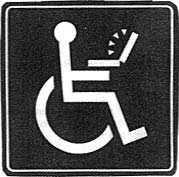
Jeremy Kahn, Fortune, © 2001 Time, Inc. All rights reserved.
 Jeremy Kahn, Fortune, © 2001 Time, Inc. All rights reserved. |
Historically, accessibility was first addressed by the United States government with the passage of the Architectural Barriers Act of 1968. Many building codes and standards have since been developed and/or altered to accommodate the physical accessibility needs of people with disabilities.
With the passage of Section 508 of the Rehabilitation Act Amendments in 1998, the definition of accessibility was broadened to include Federal electronic and information technology. Section 508 aims to provide Federal employees with disabilities access to government technology, from fax and duplication machines to computers and the World Wide Web. Section 508 regulations have the potential for being as important for assuring access to the information age as the Architectural Barriers Act was for assuring entrance into buildings.
"Bridging the digital divide is not just the morally right thing to do, it is the smart thing to do," stated President Bush. "If we build new onramps to the information super highway, people with disabilities will help us build an even stronger America, and I might add, share in the promise of the declaration of true independence" (www.access-board.gov/news/508-final.htm). News standards, developed by the Architectural and Transportation Barriers Compliance Board's (Access Board) Electronic and Information Technology Access Advisory Committee finally took effect on June 21, 2001. The Standards require Federal agencies to ensure that their 120,000 employees with disabilities have access to and use of information systems. Furthermore, the standards cover the full range of electronic and information technologies, including those used for communication, duplication, computing storage and production (Federal Register, December 21, 2000).
The new Section 508 standards require that all technological devices enable people with disabilities to locate and use information. For example--
Screen readers deliver aloud the text of a web page to the user but either skip over an image or stall when encountering charts and graphs. The web developer must always include text desctiptions of all images in the web programming code. Moreover during a video clip, audible video descriptions must be used to tell the listener about the action taking place. Video descriptions refer to important visual elements needed to follow a story line.
People with hearing impairments have no way to identify sounds used to enhance information or to verify that a computer command was performed. Now, sound must be captioned and captioning must coincide with the sound as it occurs.
In some cases, a computer user with a disability may not be able to manipulate a mouse, other pointing devices, or a keyboard. In the future, web pages must enable the person viewing the page to use software that is voice-activated to perform tasks such as entering and submitting information.
In another example, an individual might have a disorder that makes him/her sensitivie to light (e.g>, a form of epilepsy in which seqizures are triggered by flashes of light). Blinking or flashing elements in frequencies causing problems for people who are light sensitive are now prohibited.
Seventy percent of the working age populaiton of persons with disabilities represents a labor pool whose increased accessibility to electronic and information technology could enhance their employment opportunities. In the months and years ahead, increased accesibility will reduce barriers to employment and provide employers with an even larger pool of qualified personnel (Electronic and Information Technology Accessibility Standards, November 2000). Moreover, people with disabilities outside of the governemtn will have the ability to acquire information and services now provided to people without disabilities through the use of Federal accessible electronic and information technology. Federally maintained sites such as the National Park Service, U.S. Forest Service, National Weather Bureau and Library of Congress will become even more user friendly.
The cost of retrofitting web pages, as well as other hardware and software mandated by the new rules, is estimated at $690 million (Fortune, June 11, 2001). This cost pales in comparison to benefits derived if America's leading companies will develop a corporate-wide policy on accessibility. This, in turn, could increase availability of more user-friendly products and services and ultimately lead to accessible technologies becoming widespread throughout society. There is no denying that accessibilty has evolved into an industry and the neon welcome sign is glowing.